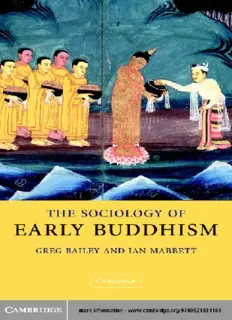
The Sociology of Early Buddhism PDF
Preview The Sociology of Early Buddhism
THE SOCIOLOGY OF EARLY BUDDHISM EarlyBuddhismflourishedbecauseitwasabletotakeupthechallenge representedbybuoyanteconomicconditionsandtheneedforcultural uniformity in the newly emergent states in northeastern India from the fifth century bce onwards. This book begins with the apparent inconsistencyofBuddhism,arenunciantmovement,survivingwithin astrongurbanenvironment,anddrawsouttheimplicationsofthis. In spite of the Buddhist ascetic imperative, the Buddha and other celebratedmonksmovedeasilythroughvariouslevelsofsocietyand fittedintotheurbanlandscapetheyinhabited.TheSociologyofEarly Buddhismtellshowandwhytheearlymonkswereabletoexploitthe social and political conditions of mid-first millennium northeastern IndiainsuchawayastoensurethegrowthofBuddhismintoamajor world religion. Its readership lies both within Buddhist studies and more widely among historians, sociologists and anthropologists of religion. greg baileyhasbeenteachingSanskrit,IndianreligionsandIndian LiteratureatLaTrobeUniversityforthepasttwenty-fouryears.He hasaPhDinIndianStudiesfromMelbourneUniversity(1980).Inthe semester1998hewasavisitingresearchfellowattheSeminarforIndian Studies and Comparative Religion at the University of Tu¨bingen. HeisamemberoftheInternationalConsultativeCommitteeofthe International Association of Sanskrit Studies and a member of the Board of the Dubvronik International Conference on the Sanskrit EpicsandPura¯n.as. ian mabbett,ReaderinHistoryatMonashUniversity,Melbourne, wasProfessorofIndianandBuddhistStudies,AichiBunkyoUniver- sity,Nagoya,2000–2,andhasmadefrequentresearchtripstoIndia and South-East Asia (including visiting forest monasteries in Thai- land).HeisauthorofAShortHistoryofIndia(1983);co-author(with DavidChandler)ofTheKhmers(1995);andcontributortoJonOrtner (photographer),Angkor:CelestialTemplesoftheKhmerEmpire(2002) andtoreferencebookssuchasTheCambridgeHistoryofSoutheastAsia (1992)andEncyclopediaofAsianHistory(1988). THE SOCIOLOGY OF EARLY BUDDHISM GREG BAILEY AND IAN MABBETT Cambridge, New York, Melbourne, Madrid, Cape Town, Singapore, São Paulo Cambridge University Press The Edinburgh Building, Cambridge , United Kingdom Published in the United States of America by Cambridge University Press, New York www.cambridge.org Information on this title: www.cambridge.org/9780521831161 © Greg Bailey and Ian Mabbett, 2003 This book is in copyright. Subject to statutory exception and to the provision of relevant collective licensing agreements, no reproduction of any part may take place without the written permission of Cambridge University Press. First published in print format 2003 - isbn-13 978-0-511-06296-4 eBook (NetLibrary) - isbn-10 0-511-06296-6 eBook (NetLibrary) - isbn-13 978-0-521-83116-1 hardback - isbn-10 0-521-83116-4 hardback Cambridge University Press has no responsibility for the persistence or accuracy of s for external or third-party internet websites referred to in this book, and does not guarantee that any content on such websites is, or will remain, accurate or appropriate. Contents Acknowledgements page vi Listofabbreviations vii Introduction 1 1 Theproblem:asceticismandurbanlife 13 context 2 Thesocialelite 39 3 Economicconditions 56 4 Urbanization,urbanismandthedevelopmentoflarge-scale politicalstructures 77 5 Brahminsandothercompetitors 108 6 Folkreligionandcosmology:meetingoftwothought worlds 138 mediation 7 Theholyman 161 8 Preparationofthemonkforthemediatoryrole.Evidence fromtheSuttaNipa¯ta 184 9 TheDhammapadaandtheimagesofthebhikkhu 196 10 ThemediatingroleasshownintheCanon 215 11 Exchange 232 Conclusion 257 Bibliography 263 Index 276 v Acknowledgements The authors wish first to acknowledge the important contribution of Peter Masefield, whose assistance during the earlier stages of the research helpedenormouslywiththeassessmentandorderingofagreatmassofPa¯li languagematerial. Responsibilityforallthatissaidinthebookrestswhollywiththeauthors, butthanksareduetothosewhohavemadecommentsandofferedadvice at points during the various stages of the work. Detailed comments on some chapters were made by J. W. de Jong, whose recent death has been agreatlosstoallwhoworkinthefield.Alsomuchappreciatedhavebeen thecommentsofRichardGombrich,DonMiller,StevenCollins,Geoffrey Samuel,JimFitzgeraldandAlfHiltebeitel. Thebookhasbenefitedparticularlyfromtheveryconstructivecriticisms of the anonymous reviewers of the manuscript. Kevin Taylor, Katharina Brett, Gillian Dadd and Joanne Hill of Cambridge University Press have helpedimprovethebookinamyriadofways. WealsoacknowledgethefinancialassistanceoftheAustralianResearch Council,whoprovidedthreeyearsoffundingtofacilitatetheinitialresearch forthisbook.WewouldalsoliketothankLaTrobeandMonashUniversities for the financial support offered to the two authors during the writing of thisbook. Finally,theauthorswishtoacknowledgethepatienceandenduranceof JaccyandKerriwhoseinspirationisalwayspresent. vi Abbreviations A An˙guttaraNika¯ya AS´ Artha´sa¯stra BrhU B.rhada¯ran.yakaUpani.sad ChU Cha¯n.d.ogyaUpani.sad D D¯ıghaNika¯ya Dhp Dhammapada Dhs Dharmasu¯tra HR HistoryofReligions IIJ Indo-IranianJournal J Ja¯taka JAOS JournaloftheAmericanOrientalSociety JESHO JournaloftheEconomicandSocialHistoryoftheOrient JIABS JournaloftheInternationalAssociationofBuddhistStudies M MajjhimaNika¯ya Mbh Maha¯bha¯rata MP MilindaPan˜ha PTS PaliTextSociety S Sam. yuttaNika¯ya Sn SuttaNipa¯ta Ud Uda¯na Vin Vinaya WZKSA WienerZeitschriftfu¨rdieKundeSu¨dasiens ZDMG ZeitschriftderDeutschenMorgenla¨ndischenGesellschaft vii Introduction [Ifamonk]hasutterlydestroyedeveryvestigeofworldlycontamination,ifheis nottiedtoanysourceofsustenance,ifhisterritoryisfreedom,thenthepassing ofsuchaoneishardtotrace,likethatofbirdsinthesky. Theideaoftotaldetachmentpervadingthisverseillustratesconciselythe fundamental ambience associated with the early Buddhist quest: detach- ment, freedom from ties, renunciation of the world, celibacy. As both religiousattitudeandlifestylepractice,adoptionofanattitudeoftotalde- tachmenthasdonemuchtodefinetheimageofthemonkthroughoutthe agessincethebeginningsofBuddhism.Intheworldtoday,andinseveral recentcenturiesforwhichgoodevidenceisavailable,thereisnodoubtthat the Order of Buddhist monks has had plenty of interaction with society; in many countries it has necessarily been integrated within the pattern of social, cultural and even political systems. A fundamental dichotomy ap- pears then as the monks who received the earliest Buddhist message were expected to live it as homeless mendicants, severing all ties with society in order to devote themselves fully to the search for enlightenment. The problem faced in this book is to explain how, right from the beginning, BuddhismhasfromadoctrinalviewpointrequiredofitsOrderofmonks the practical application of an ethic of renunciation and detachment and yet this very same order has remained a vibrant part of society, culture or politicswhereverBuddhismhasflourished. The present study confronts this problem by focusing on the relation- shipsbetweenBuddhism,understoodasitsteachingsandtheactivitiesof the Buddhist Order, and its social context in northern India in about the fifthtothirdcenturiesbce,assumingthatthesewerethecenturiesduring which the Pa¯li Canon took shape, though its formation could have con- tinuedforanothertwohundredyears.Attentionisgivenespeciallytothe socialdynamicofthegrowthofBuddhism,adynamicunderstoodwithin the terms of the opposition suggested in the first paragraph. Inevitably 1
